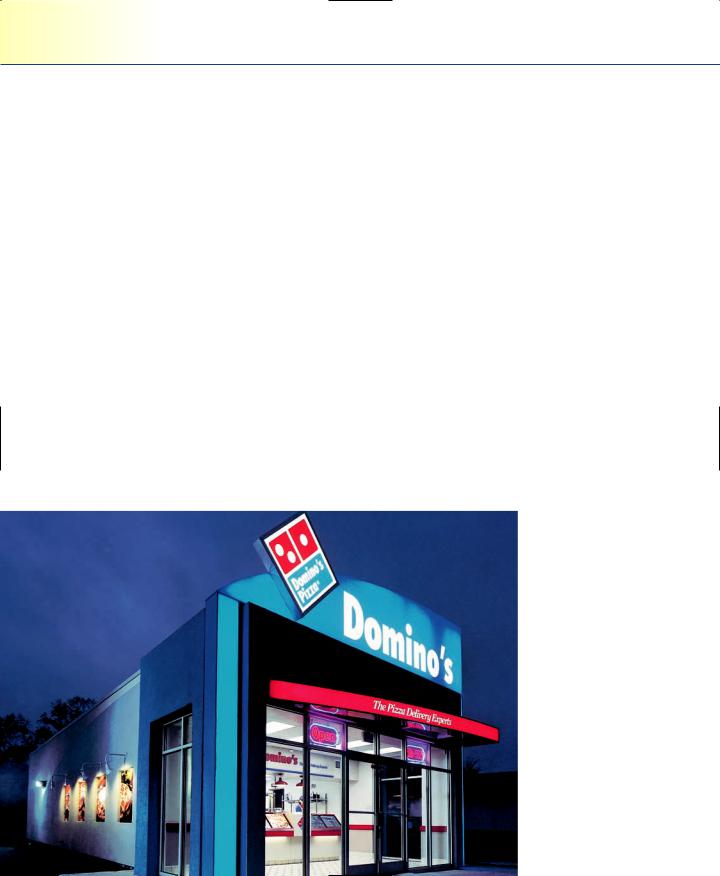
- •CONTENTS
- •PREFACE
- •Content—Benefits for Students
- •Content—Benefits for Instructors
- •Features of the Book for Students and Instructors
- •Supplementary Materials
- •Acknowledgments
- •What Is Hospitality Management?
- •The Manager’s Role in the Hospitality Industry
- •Why Study in a Hospitality Management Program?
- •Planning a Career
- •Employment as an Important Part of Your Education
- •Getting a Job
- •Employment at Graduation
- •The Outlook for Hospitality
- •Summary
- •Managing Change
- •Demand
- •Supply
- •Workforce Diversity
- •The Impact of Labor Scarcity
- •Summary
- •The Varied Field of Food Service
- •The Restaurant Business
- •The Dining Market and the Eating Market
- •Contemporary Popular-Priced Restaurants
- •Restaurants as Part of a Larger Business
- •Summary
- •Restaurant Operations
- •Making a Profit in Food Service Operations
- •Life in the Restaurant Business
- •Summary
- •Chain Restaurant Systems
- •Independent Restaurants
- •Franchised Restaurants
- •Summary
- •Competitive Conditions in Food Service
- •The Marketing Mix
- •Competition with Other Industries
- •Summary
- •Self-Operated Facilities
- •Managed-Services Companies
- •Business and Industry Food Service
- •College and University Food Service
- •Health Care Food Service
- •School and Community Food Service
- •Other Segments
- •Vending
- •Summary
- •Consumer Concerns
- •Food Service and the Environment
- •Technology
- •Summary
- •The Evolution of Lodging
- •Classifications of Hotel Properties
- •Types of Travelers
- •Anticipating Guest Needs in Providing Hospitality Service
- •Service, Service, Service
- •Summary
- •Major Functional Departments
- •The Rooms Side of the House
- •Hotel Food and Beverage Operations
- •Staff and Support Departments
- •Income and Expense Patterns and Control
- •Entry Ports and Careers
- •Summary
- •The Economics of the Hotel Business
- •Dimensions of the Hotel Investment Decision
- •Summary
- •The Conditions of Competition
- •The Marketing Mix in Lodging
- •Product in a Segmented Market
- •Price and Pricing Tactics
- •Place—and Places
- •Promotion: Marketing Communication
- •Summary
- •The Importance of Tourism
- •Travel Trends
- •The Economic Significance of Tourism
- •The United States as an International Tourist Attraction
- •Businesses Serving the Traveler
- •Noneconomic Effects of Tourism
- •Summary
- •Motives and Destinations
- •Mass-Market Tourism
- •Planned Play Environments
- •Casinos and Gaming
- •Urban Entertainment Centers
- •Temporary Attractions: Fairs and Festivals
- •Natural Environments
- •On a Lighter Note. . .
- •Summary
- •Management and Supervision
- •The Economizing Society
- •The Managerial Revolution
- •Management: A Dynamic Force in a Changing Industry
- •What Is Management?
- •Summary
- •Why Study Planning?
- •Planning in Organizations
- •Goal Setting
- •Planning in Operations
- •The Individual Worker as Planner
- •Long-Range Planning Tools
- •Summary
- •Authority: The Cement of Organizations
- •Departmentalization
- •Line and Staff
- •Issues in Organizing
- •Summary
- •Issues in Human-Resources Management
- •Fitting People to Jobs
- •Recruiting
- •Selection and Employment
- •Training
- •Retaining Employees
- •Staff Planning
- •Summary
- •The Importance of Control
- •Control and the “Cybernetic Loop”
- •Tools for Control
- •Summary
- •Leadership as Viewed by Social Scientists
- •Why People Follow
- •Leadership Theories
- •Communication
- •The Elements of Leading and Directing
- •Developing Your Own Leadership Style
- •Summary
- •A Study of Service
- •Rendering Personal Service
- •Managing the Service Transaction
- •How Companies Organize for Service
- •Summary
- •INDEX

The Hospitality Industry and You
Whichever the segment, the hospitality industry has always attracted its share of entrepreneurs for the simple reason that it offers everything that smallbusiness owners are looking for. One characteristic that very much appeals to independent-minded individuals is being able to be your own boss.
There are many other opportunities as well. For instance, people with chef’s training may open their own business, especially if they feel that they have a sufficient management background. In the health care area, home care organizations are expanding in response to the needs of our growing senior-citizen population and offer a wide range of opportunities to entrepreneurs.
Whether you’re studying hospitality management because you want to start a business of your own or because you found your past work experience in the business especially interesting—or perhaps just because the need for managers in the area makes the job prospects attractive—management studies are an important preparation for budding entrepreneurs. Hospitality management students tend to be highly motivated, lively people who take pride in their future in a career of ser-
vice. Starting positions that hospitality, tourism and culinary students typically accept upon graduation are presented in Figure 1.2.
Planning a Career
THE MEANING OF WORK
We all have several motives for going to work. We work to live—to provide food, clothing, and shelter. Psychologists and sociologists tell us, however, that our work also provides a sense of who we are and binds us to the community in which we live. The ancient Greeks, who had slaves to perform menial tasks, saw work as a curse. Their Hebrew contemporaries saw it as punishment. Early Christians, too, saw work for profit as offensive. By the time of the Middle Ages, however, people began to accept work as a vocation, that is, as a calling from God. Gradually, as working conditions improved and work became something that all social classes did, it became a necessary part of maturation and self-fulfillment in our society.

Employment as an Important Part of Your Education |
11 |
Today, workers at all levels demand more than just a job. Indeed, work has been defined as “an activity that produces something of value for other people.”2 This definition puts work into a social context. That is, it implies that there is a social purpose to work, as well as the crude purpose of survival. It is an important achievement in human history that the majority of North Americans can define their own approach to a life of work as something more than mere survival.
Work contributes to our self-esteem in two ways. First, by doing our work well, we prove our own competence to ourselves. Psychologists tell us that this is essential to a healthy life, as this information gives us a sense of control over both our environment and ourselves. Second, by working, we contribute to others—others come to depend on us. Human beings, as social animals, need this sense of participation. For these reasons, what happens at work becomes a large part of our sense of self-worth.
Education, too, is clearly important. Indeed, education has become essential in most walks of life. There is, moreover, a clear connection between education, work, and income. Studies have shown that workers with a post secondary education earn much more annually than workers with just a high-school education. This difference is expected to grow as the demand for “knowledge workers” continues to increase. The evidence, then, is that your commitment to education will pay off.
The next section explores career planning in regard to employment decisions that you must make while you are still in school. We will also discuss selecting your first employer when you leave school. If you’ve chosen the hospitality industry as your career, this section will help you map out your job plans. If you are still undecided, the section should help you think about this field in a more concrete way and give you some ideas about exploring your career through part-time employment. A large number of those reading this text already have significant work experience, many in hospitality fields. Because not everyone has such experience in his or her background, however, this is a subject that does need to be covered. Perhaps those with more experience will find this a useful opportunity to review plans they’ve already made. Taking a fresh look at your commitments is always worthwhile.
It’s hard to overstate the importance of career planning.
Employment as an Important
Part of Your Education
Profit in a business is treated in two ways. Some is paid out to the owner or shareholders as dividends (return on their investment). Some of the profit, however, is retained by the business to provide funds for future growth. This portion of profit that is not paid out is called retained earnings. We need the concept of retained earnings
to consider the real place of work experience in career development.

12 |
Chapter 1 The Hospitality Industry and You |
PROFITING FROM WORK EXPERIENCE
The most obvious profit you earn from work is the income paid to you by an employer. In the early years of your career, however, there are other kinds of benefits that are at least as important as income. The key to understanding this statement is the idea of a lifetime income. You’ll obviously need income over your entire life span, but giving up some income now may gain you income (and, we ought to note, enjoyment, a sense of satisfaction, and independence) just a few years later. There is, then, a job benefit mix made up of both money and knowledge to be gained from any job. Knowledge gained today can be traded with an employer for income tomorrow: a better salary for a more qualified person. The decision to take a job that will add to your knowledge is thus a decision for retained earnings and for acquiring knowledge that you can use later. Many graduates choose their first job on the basis of salary without concern for the potential long-term advantages that one job may offer over another.
Every job, therefore, has to be weighed according to its benefit mix, not just in terms of the dollar income it provides. A part-time job at a retail store might seem attractive because it pays more than a job busing dishes does. However, if you think about the learning portion of the benefit mix and your total income, including what you learn, your decision may—and probably should—be for the job that will add to your professional education.
There is another important point to consider about retained earnings and the benefit mix. Often the only part-time jobs in the industry available to students are unskilled
Hospitality takes many forms including fast growing areas such as takeout and delivery. (Courtesy of Domino’s Pizza, Inc.)

Employment as an Important Part of Your Education |
13 |
ones. Many people find these jobs dull, and they often pay poorly. If you think about these jobs in terms of their total income, however, you may change your perspective. Although the work of a busperson or a dishwasher may not be very challenging, you can improve your total profits from such a job by resolving to learn all you can about the operation. In this way, you can build your retained earnings—the bank of skills and knowledge that nobody can ever take away from you.
LEARNING STRATEGIES FOR WORK EXPERIENCE
When you go to work, regardless of the position you take, you can learn a good deal through careful observation. Look first at how the operation is organized. More specifically, look at both its managerial organization and its physical organization.
Managerial Organization. Who is the boss? Who reports to (or works directly with) him or her? Is the work divided into definite departments or sections? Is one person responsible for each department? To whom do the department staff members report? If you can answer these questions, you will have figured out the formal managerial organization of the operation. Indeed, most large companies will have an organization chart that you can look at. If your employer doesn’t have such a chart, ask him or her to explain the organization to you. You’ll be surprised at how helpful to hospitality management students most employers and supervisors are.
While you’re thinking about organization, it is also important to notice the informal organization, also known as the social organization, of the group with which you are working. Which of the workers are influential? Who seem to be the informal leaders? Why? Most work groups are made up of cliques with informal leaders. After you identify this informal structure, ask yourself how management deals with it. Remember that someday the management of these informal organizations will be your challenge; in time, you will be helping to manage the organization, and you will need their cooperation. In the meantime, this firsthand experience will help you both in your studies and in sizing up the real world of work.
The Physical Plant. You can learn a great deal about a physical plant by making a simple drawing of your workplace, such as the one shown in Figure 1.3. On this drawing, identify the main work areas and major pieces of equipment. Then begin to note on it where you see problems resulting from cross traffic or bottlenecks. For example, if you’re working in the back of the house, you can chart the flow of products from the back door (receiver) to storage and from there to preparation. You should also trace the flow of dishes. Dirty dishes come to the dish room window and go to the clean-supply area after washing. How are they transported to the line or to the

Figure 1.3
A sample layout.
|
Bar |
|
entrance |
|
Lobby |
|
Dining room |
Cocktail lounge |
|
|
Kitchen |
Folding |
Divider |
Stacking area |
|
Storage area |
|
pantry people for use in service? If you are working in the back of the house, you will be looking mostly at the flow of kitchen workers and dishes from the viewpoint of the kitchen, dish room, or pantry. A similar flow analysis of guests and servers (and plates) can also be made from the front of the house (i.e., the dining room).
A study of guest flow in a hotel lobby can also be educational. Trace the flow of room guests, restaurant guests, banquet department guests, and service employees arriving through the lobby. Where do you observe congestion?
These simple charting activities will give you some practical experience that will be useful for later courses in layout and design and in food service operations and
14
